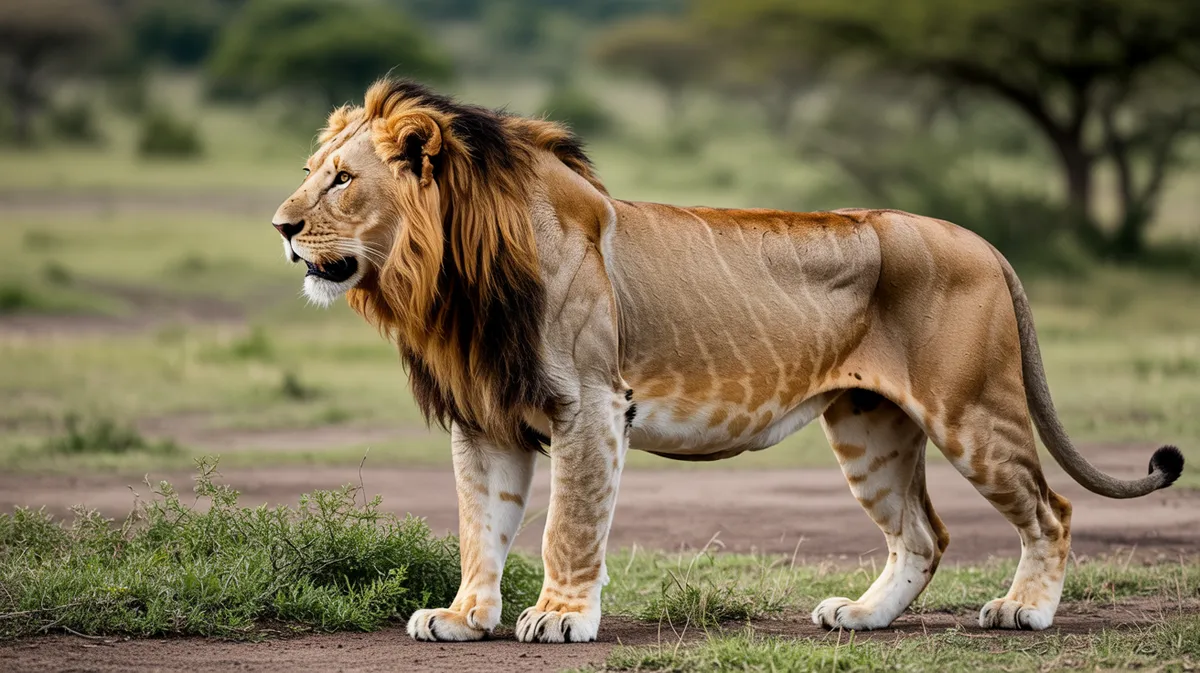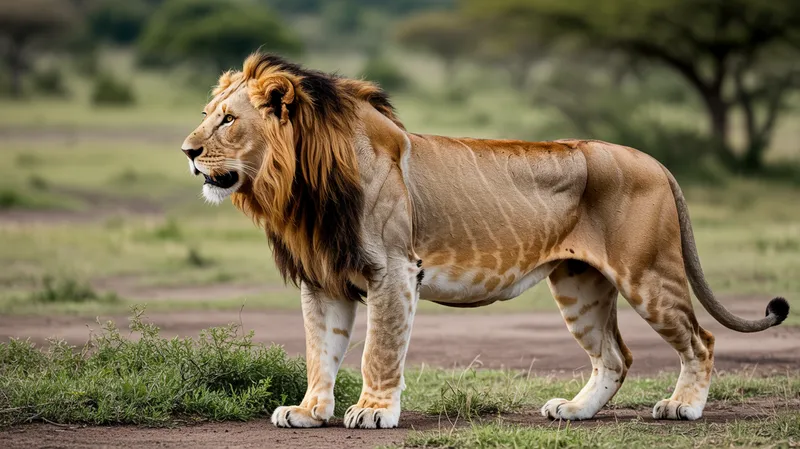
African Lion
Panthera leo

Meet the African Lion
The African Lion is a large, muscular carnivorous mammal native to the grasslands, savannas, and open woodlands of sub-Saharan Africa. Known for their majestic manes and powerful build, male lions can be distinguished by their impressive hair around the head and neck, while females are more streamlined. Lions are highly social animals, living in prides that can include up to 30 individuals, which is unusual among big cats. As apex predators, they play a crucial role in maintaining the health and balance of their ecosystem.
Classification
Mammal
Habitat
Savanna
Diet
Carnivore
Lifespan
8-15 years in the wild
Conservation
Vulnerable
Weight
120–250 kg (265–550 lbs)
📖Fascinating Facts
Social Structure
Lions are the only truly social cats, forming prides that can consist of several females, their cubs, and a coalition of males.
Habitat Range
African lions primarily inhabit savannas and grasslands, but they can also be found in open woodlands and scrublands across sub-Saharan Africa.
Powerful Predators
Lions are apex predators and typically hunt large ungulates, such as zebras, wildebeests, and buffalos, often relying on teamwork to catch their prey.
📋Detailed Description
The African Lion (Panthera leo) is the second-largest living feline, with adult males typically weighing 150–250 kg (330–550 lbs) and females 110–180 kg (240–400 lbs), though exceptional individuals can exceed these ranges. Males are distinguished by their prominent manes, which vary in color and length and serve both as a visual signal of fitness and as protection during intraspecific combat. Lions possess a robust, muscular build, powerful forelimbs, and retractable claws, enabling them to tackle large prey. Their fur is generally tawny, providing camouflage in grassland habitats, while cubs are born with faint spots that fade with age. Lions are unique among felids for their complex social structure, living in prides that can consist of 3–12 females, their offspring, and 1–6 adult males. Social bonds are reinforced through grooming, nuzzling, and vocalizations such as roaring, which can be heard up to 8 km (5 mi) away. Lions are crepuscular, most active at dawn and dusk, and spend up to 20 hours per day resting. As apex predators, they primarily hunt medium to large ungulates, but their diet is highly adaptable, including scavenging and opportunistic feeding. Reproduction is non-seasonal, with females synchronizing births to facilitate communal care of cubs. Cubs are vulnerable to predation and infanticide, with survival rates often below 50% in the first year.
💡 Did you know?
Female lions, or lionesses, do most of the hunting for the pride and coordinate their efforts to take down large prey.
🔬Research & Sources
Wikipedia Summary
The lion is a large cat of the genus Panthera, native to Sub-Saharan Africa and India. It has a muscular, broad-chested body; a short, rounded head; round ears; and a dark, hairy tuft at the tip of its tail. It is sexually dimorphic; adult male lions are larger than females and have a prominent mane. It is a social species, forming groups called prides. A lion's pride consists of a few adult males, related females, and cubs. Groups of female lions usually hunt together, preying mostly on medium-sized and large ungulates. The lion is an apex and keystone predator.
Last Modified: 6/8/2025
🎭Behavior & Social Structure
African lions exhibit highly coordinated group behaviors, particularly during hunting, where lionesses employ strategic ambush and flanking tactics to maximize success. Males rarely participate in hunts, instead focusing on territory defense and protection of the pride. Social hierarchies are maintained through subtle dominance displays, grooming, and vocal communication. Territorial boundaries are marked by scent marking and roaring. Daily routines are dominated by rest, with activity peaking during cooler hours. Play behavior is common among cubs and juveniles, serving as practice for adult skills. Cooperative cub rearing is observed, with females sharing nursing and protection duties. Intra-pride aggression is rare, but coalitions of males may engage in violent takeovers, resulting in infanticide of unrelated cubs.
👶Reproduction & Life Cycle
Lions are polygynous, with dominant males mating with multiple females in the pride. Estrus in females lasts 4–7 days, and copulation occurs frequently—up to 50 times per day—stimulating ovulation. Gestation lasts approximately 110 days, after which females give birth to litters of 1–4 cubs in secluded dens. Cubs are born blind and helpless, weighing 1.1–1.6 kg (2.4–3.5 lbs). Mothers move cubs between dens to avoid detection by predators and rival males. Cubs are introduced to the pride at 6–8 weeks and are weaned by 6–7 months, though they may continue suckling for longer. Mortality is high due to predation (by hyenas, leopards, and other lions), disease, and starvation. Females can breed year-round, with interbirth intervals of 18–26 months if cubs survive, but shorter if cubs are lost.
🛡️Adaptations & Survival
Lions possess several adaptations for their predatory lifestyle: powerful jaws and canine teeth for subduing large prey; a flexible spine and strong forelimbs for grappling; and a rough tongue for stripping flesh from bones. Their social structure allows for cooperative hunting, increasing efficiency and enabling them to capture prey larger than themselves, such as buffalo or giraffe. The mane of the male provides both a visual deterrent to rivals and physical protection during fights. Their acute night vision, enhanced by a high density of rod cells and a reflective tapetum lucidum, allows effective hunting in low light. Vocalizations, including the iconic roar, facilitate long-distance communication and territory advertisement. Behavioral flexibility enables lions to adapt to varying prey availability and environmental conditions.
🎨Cultural Significance
Lions have held profound symbolic importance across African and global cultures for millennia, representing strength, royalty, and courage. They feature prominently in folklore, heraldry, and national emblems (e.g., Ethiopia, Kenya). In traditional African societies, lions are revered in oral traditions and rituals, sometimes associated with ancestral spirits or as totems. The lion's image is widely used in art, literature, and modern media, reinforcing its status as an icon of wilderness and power. However, traditional uses of lion parts for medicine or ritual persist in some regions, contributing to illegal trade.
🔬Recent Research & Discoveries
Recent research has focused on lion genetics, revealing distinct northern and southern subspecies (P. l. leo and P. l. melanochaita) with implications for conservation management. GPS collaring and remote camera traps have improved understanding of lion movement ecology, territory size (ranging from 20 to over 400 km²), and human-lion conflict hotspots. Studies on vocal communication have elucidated the function and individuality of roars. Ongoing research addresses the impact of trophy hunting, disease transmission from domestic animals, and the effectiveness of community-based conservation initiatives. Conservation genomics and landscape connectivity modeling are emerging fields aimed at preserving genetic diversity and viable populations.
🎥Wildlife Videos

LION KING | The Secrets of the Rulers | Animal documentary
LION KING | The Secrets of the Rulers Welcome to the vibrant world of wildlife! Today, we embark on a thrilling journey to ...
WILD NATURE - Nature animal documentary

Lions: Kings of the Savannah | Roar of the Wild Ep. 1 | 4K UHD Documentary
"Lion Brothers - A Dangerous Family: The Route to the Top" takes an in-depth look at the fascinating and perilous world of lions, ...
space and science

Lions Rule | Episode 1: Death in the Glade | Free Documentary Nature
Lions Rule - Episode 1: Death in the Glade | Wildlife Documentary Watch 'Lions Rule - Episode 2' here: ...
Free Documentary - Nature

The First Five Years | Lion Brothers: Cubs to Kings
There's one thing that Leo has on his mind from birth – power! And he'll stop at nothing to get it. But life has other ideas and throws ...
Love Nature

Lions Rule | Episode 2: Hunting Giants | Free Documentary Nature
Lions' Rule - Episode 2: Hunting Giants | Wildlife Documentary Watch 'Lions' Rule - Episode 3' here: ...
Free Documentary - Nature

White Lions - An Epic Battle for Survival | Free Documentary Nature
White Lions - An Epic Battel for Survival | Wildlife Documentary Watch 'The Last Lion of the Liuwa Plain' here: ...
Free Documentary - Nature
🌍Habitat Information
The African Lion typically inhabits Savanna environments. African Lions have adapted to their environments with specialized features and behaviors.
Primary Habitat:
Savanna
More detailed habitat information will be available soon.
🛡️Conservation Status
The African Lion is currently classified as Vulnerable. Conservation efforts are crucial for preserving this species for future generations.
Common Threats:
- 🏠Habitat loss and fragmentation
- 🌡️Climate change impacts
- 🎯Hunting and poaching
- 🏭Human-wildlife conflict
⚠️Threats & Conservation Challenges
African lion populations have declined by over 40% in the past two decades, with current estimates placing the wild population at 23,000–39,000 individuals. Major threats include habitat loss and fragmentation due to agriculture and human settlement, depletion of prey base, retaliatory killings by pastoralists, and poaching for body parts. Disease outbreaks, such as canine distemper and bovine tuberculosis, have caused localized declines. Genetic isolation in small, fragmented populations increases vulnerability to inbreeding depression. Human-lion conflict is a significant conservation challenge, particularly outside protected areas. Climate change may exacerbate these pressures by altering prey distribution and water availability.
🔬Scientific Classification
Scientific Name
Panthera leo
Classification Hierarchy
🔍 About Taxonomic Classification
Taxonomic classification is a hierarchical system used by scientists to classify and organize living organisms based on shared characteristics and evolutionary relationships.
The system moves from broad categories (Kingdom) to increasingly specific ones, with each animal's scientific name typically consisting of its Genus and species.
📝Community Notes
Share your observations and insights about the African Lion with our community of wildlife enthusiasts.
Join Our Community
Sign in to share your observations and connect with fellow wildlife enthusiasts.
Sign In to ContributeNo community notes yet
Be the first to share your observations about the African Lion!
Explore African Lion
Select a tab above to learn more about this amazing animal.
📸Photo Gallery
No photos available for this animal yet.
🌟Discover More Wildlife
Continue your journey of discovery with more fascinating animals from our database
